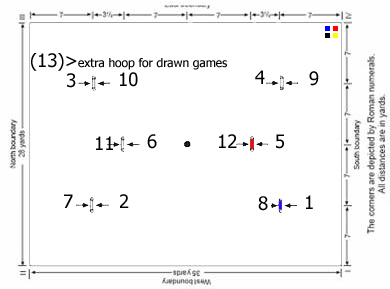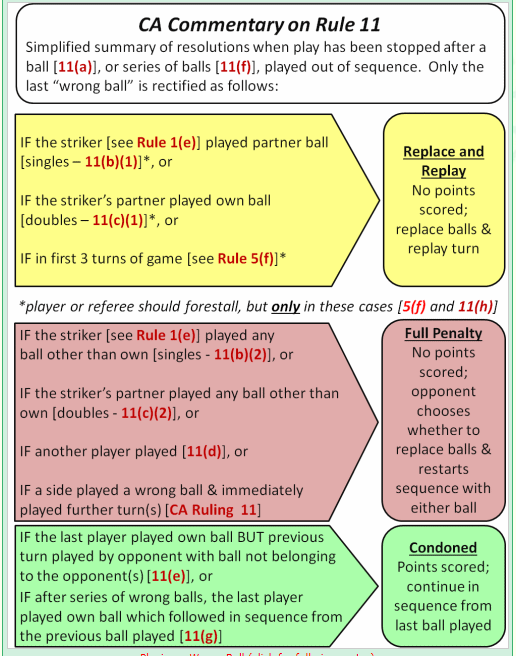Playing Guides
Golf Croquet playing guides which are worthy of a fresh look each new season,
the following can all be found by scrolling down the page:
- Beginners Guide to Croquet Jargon
- Ken's 7 Essential Golf Croquet Basics
- Ken's Next 7 Essential basics for Golf Croquet
- Enfield Croquet Etiquette
- Guide to the Golf Croquet Wrong Ball Laws
* Beginners Guide to Croquet Jargon
Advance
To cause to move another ball to a position of tactical advantage.
Bisque(s)
The original term for extra turns provided in handicap play.
Blob
Accidentally failing to score a hoop with the ball remaining in the jaws.
Block
To position a ball to obstruct the path of an opponent's ball.
Cannon
To deflect one ball off another with the objective of moving a third ball and/or scoring a hoop.
Centre Peg
The annoying stake between hoops 5 & 6 which gets in the way and appears to have no purpose in Golf Croquet other than preventing a direct shot from the jaws of
hoop 5 to 6. It is however used in Association Croquet matches to peg out and complete a match.
Clear
To remove an opponent's ball from a position of tactical advantage. Referred to as a clearance shot.
Clip - The pegs placed on the hoops which are used for scoring.
Court
An alternative name for a lawn.
Cut rush
To rush another ball at an angle. The resting place of either ball or both may be the object of such a stroke. Also known as playing an angled shot.
Damage
Anything that makes a mark on the lawns, usually with a mallet. Accidents happen, so just repair or report any damage.
Dambuster
A bouncing shot. Or a jump shot over a long distance requiring one or more bounces of the ball. Please don’t try this until you have sufficient expertise.
Dead ground
Describes the area of the court within which one ball is wired from another.
Dolly rush
A rush from a very short distance away from the target ball.
Doubles - When a team comprises two players.
Extra turn(s)
Additional shots awarded when playing a handicap match which are calculated by the difference in handicaps between the players.
Go for or take position
To position the striker's ball in a position of practical advantage, usually threatening the hoop.
Hampered
A shot where the striker's normal stance and/or swing is hindered by a hoop, the peg or another ball.
Hit away
To remove an opponent's ball from a position of tactical advantage. See also 'clear'.
In-off
Scoring a hoop off another ball.
Jaws
The area between the uprights of a hoop. Used as a verb to indicate the deliberate placement of a ball within the jaws.
Jump shot - A shot where the ball is hit hard into the ground, causing it to jump up and over another ball or even the hoop. Please don’t try this until you have sufficient expertise and
please practise off the lawns.
Lawn
Refers to the playing area marked out by the white lines.
Nestle
Synonymous with 'to jaws' or 'put it in the jaws' but also used to describe placing a ball close to an opponent's to make it difficult to play without
faulting.
Offside
Describes balls which when a hoop is scored, are resting beyond the halfway line between the hoop scored and the next hoop in order.
Peel
Scoring a point for a ball other than the striker's by putting it through the next hoop in order.
Primaries
Primary balls are the set which are blue, red, black & yellow and are the balls used when playing the first match when two matches are on the lawn.
Promote - To cause a partner ball to move to an advantageous position for its next turn. Knocking it forward to a better position.
Run a hoop or Running a hoop
To score.
Rush
To cause to move another ball to a position of tactical advantage.
Secondaries
Secondary balls are the set which are green, pink, brown & white and are the balls used in a second match when primaries are already in use on the lawn.
Singles
When two individuals play a match against each other.
Stop shot
To hit away another ball from a very short distance with the objective of striker's ball stopping close to the starting point of the target ball.
Striker
The person whose turn it is to play his or her stroke.
Striker’s Ball – The next ball in order of play is the striker's ball
Stun shot
same as a stop shot
Wired
A position where a ball is prevented by the hoops or the peg from hitting or being hit by another ball.
Wrong ball
he play of any ball other than the 'striker' playing the 'striker’s ball'. See the 'Guide to the Golf Croquet Wrong Ball Law' below for further details.
Association croquet has additional jargon – but that’s for another day.
* Ken's 7 Essential Golf Croquet Basics
Guidelines to the seven principle requirements when playing Golf Croquet.
1 Most importantly learn to strike the ball cleanly. Think 'smooth swing' with a straight and clean follow through avoiding any jerky movements of your head or body.
2 Learn to place the ball exactly where you want it - direction and pace are both crucial. Consider also any gradient over which your ball will travel and how this will effect the pace or possible
direction of your shot.
3 Practise rushing the ball to clear an opponent (knocking away an opponent's ball)
4 Practise the stop shot to clear your opponent and to leave yourself in good position
5 Running the hoop. Practise from varying distances. Also know how likely you are to run the hoop from variable ranges and angles to help you assess the risk of various shots.
6 Know the route - as shown below
7 How to best use bisques (any extra turns you may have according to your handicap)
* Ken's Next Seven Essential Basics for Golf Croquet
Knowing the rules
Knowing the rules, especially knowing when your opponent has made a foul shot. Knowing when to call a referee if there is the potential for a foul shot. Also be aware of the variation in rules for
playing the wrong ball between singles and doubles matches.
Foresight
Think several turns ahead. Anticipate your opponent's moves. Always consider the variable preferable options.
Strengths and Weaknesses
Assess the strengths and weaknesses of an opponent early. How far can they hit a ball, how accurately and from what distance can they run hoops. In doubles the strongest player should try to precede
the opponents' best player.
Use other balls
Promote the partner ball using a cannon for good position or to run a hoop. Also play off an opponent ball to the next hoop where possible if the current hoop is hopeless cause.
Accuracy
Accuracy of placement is important. There are fewer varieties of shot than in Association so accuracy plays a bigger part than tactics. Accuracy of hoop running and hitting other balls are well
worthy of practice.
Aggressiveness
Running hoops from greater distances is good practice as there is a smaller penalty to be paid for missing. Jump shots are well worth learning. As is running or hitting another ball a considerable
distance.
Decisive Use of Extra Turns
If you have extra turns then stopping an opponent running a hoop is not the best use for them. Unless in doing so it gives your partner ball a good chance to run the hoop. Using the extra turn when
playing first towards a new hoop to set up a near certain running of that hoop is preferable.
For those who've forgotten their first lessons in Golf Croquet:
Enfield Croquet Etiquette
When not playing
Never walk across the lawns unless you are playing a match. Other than when participating players invite a 'referee' to assist no one should enter the courts at any time under any circumstances. This
includes Committee members.
Never walk on ground under repair, even to inspect it, unless you are the groundsman.
Never shout at, or to players from the sidelines. Your intent may be helpful but you will also unintentionally distract other players on other lawns.
Pre-match and post match
- Arrive on time and always offer help to set out the courts.
- Always ensure the lawns are cleared of any foxes mess prior to play - this is a hazard many seemingly never see (there is a trowel available close at hand for this very purpose). Likewise all unwanted litter is best removed prior to play.
- Never wheel equipment across the lawns unless you are the groundsman. Trolleys should always be wheeled around the lawns on the pathways provided.
- Players borrowing mallets should take personal responsibility for them and ensure their safe return to the clubhouse.
- Players should take care to ensure that entire sets of balls are returned to the clubhouse via the trolleys. Similarly with pegs, clips and all other equipment used.
- Please report any areas of the lawns that require repair to a Committee Member. Or if you feel able then simply repair it.
When Playing
- Always play in groups of four whenever the lawns are busy.
- Singles Competition games should not be played on Club afternoons if the lawns are busy.
- Take great care not to damage the courts and report any damage please.
- Never stand in the sight line of a player taking his or her shot.
- Stand still and remain quiet whilst your fellow competitors take their shots.
- Slow play is to the detriment of all. So please move briskly between shots without getting in the line of fire of your fellow competitors or other matches. Always be ready to play your shot in turn. Social chit-chat is fine but shouldn't ever be allowed to delay play.
- Balls that travel off the lawns are best retrieved immediately, especially so if they disappear into undergrowth.
- Always ask permission when playing across or through another match on the same lawn.
- Always ask permission to mark the position of a ball belonging to another match.
- Assist others to appreciate the etiquette required on Enfield's lawns.
- Thank you for abiding by these simple but effective standards
* Guide to the Golf Croquet Wrong Ball Law
.... and good luck with that one.
It can seem quite complex at first, but you will get there.




